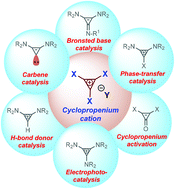Recent advances in the organocatalytic applications of cyclopropene- and cyclopropenium-based small molecules
Abstract
The development of novel small molecule-based catalysts for organic transformations has increased noticeably in the last two decades. A very recent addition to this particular research area is cyclopropene- and cyclopropenium-based catalysts. At one point in time, particularly in the mid-20th century, much attention was focused on the structural aspects and physical properties of cyclopropene-based compounds. However, a paradigm shift was observed in the late 20th century, and the focus shifted to the synthetic utility of these compounds. In fact, a wide range of cyclopropene derivatives have been found serving as valuable synthons for the construction of carbocycles, heterocycles and other useful organic compounds. In the last few years, the catalytic applications of cyclopropene/cyclopropenium-based compounds have been uncovered and many synthetic protocols have been developed using cyclopropene-based compounds as organocatalysts. Therefore, the main objective of this review is to highlight recent developments in the catalytic applications of cyclopropene-based small molecules in different areas of organocatalysis such as phase-transfer catalysis (PTC), Brønsted base catalysis, hydrogen-bond donor catalysis, nucleophilic carbene catalysis, and electrophotocatalysis developed within the past two decades.

- This article is part of the themed collection: Catalysis & biocatalysis in OBC


 Please wait while we load your content...
Please wait while we load your content...